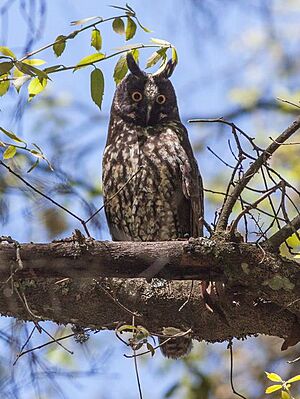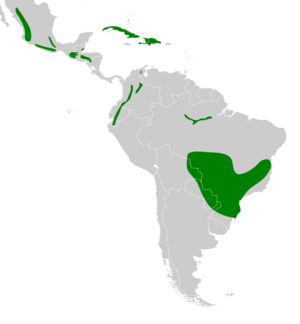Stygian owl facts for kids
Quick facts for kids Stygian owl |
|
|---|---|
 |
|
| Conservation status | |
| Scientific classification | |
| Genus: |
Asio
|
| Species: |
stygius
|
 |
|
The Stygian owl (Asio stygius) is a cool, medium-sized owl. It's often called a "typical owl." You can find it in Mexico, parts of Central America, Cuba, Hispaniola, and 10 countries in South America.
Contents
Meet the Stygian Owl: What It Looks Like
The Stygian owl is about 38 to 46 centimeters (15 to 18 inches) long. It weighs around 400 to 675 grams (14 to 24 ounces). Both male and female owls look very similar. They have very dark feathers. The word "Stygian" means dark or gloomy, like the mythical River Styx. This name fits the owl's dark look!
Its face is dark, almost black, with a lighter edge. It has a whitish forehead. Long, dark feathers stick up from its head, looking like "ears." The top part of its body is dark with light streaks and stripes. Its belly is a dull, light brown with dark brown or black stripes.
The owl's eyes are yellow. Its beak is dark blue or black. Its feet are dark grayish or brownish pink. Sometimes, its eyes might even look red. This happens because they reflect light in a special way. Different types of Stygian owls look mostly the same. They mainly differ in how dark their upper feathers are and a little bit in size.
Where Stygian Owls Live: Their Homes Around the World
Stygian owls live in many different places. They can be found from sea level up to 3,000 meters (9,800 feet) high. They prefer areas that are fairly open. These are not usually super dense forests or just wide-open grasslands.
You might find them in mountain pine forests or pine-oak forests. They also live in cloud forests, thorny bushes, and even pine tree farms. Sometimes, they even live in city parks!
There are six types, or subspecies, of the Stygian owl. Each one lives in a specific area:
- A. s. lambi lives in northwestern Mexico. This includes areas from Sonora and Chihuahua down to Jalisco.
- A. s. robustus is found in parts of Mexico, from Guerrero and Veracruz south into northern Nicaragua.
- A. s. siguapa lives on the main island of Cuba and Isla de la Juventud.
- A. s. noctipetens lives on the main island of Hispaniola and Gonâve Island.
- A. s. stygius is found in Colombia and Venezuela. Its range goes south to Bolivia and parts of central and southern Brazil.
- A. s. barberoi lives in Paraguay and northern Argentina.
Sometimes, a Stygian owl might fly to a place it doesn't usually live. This is called being a "vagrant." Stygian owls have been seen as vagrants in Texas, Florida, and Trinidad.
Stygian Owl Behavior: What They Do
Movement and Travel
As far as we know, Stygian owls usually stay in the same area their whole lives. They don't migrate long distances.
Feeding Habits: What Stygian Owls Eat
The Stygian owl is a nocturnal animal. This means it is active mostly at night. Most of its food is birds. It hunts birds of all sizes, from very small ones to larger ones like the lesser nothura. Scientists think these owls catch most birds while they are sleeping at night.
Stygian owls also eat bats! This is quite rare for owls. They also hunt some other mammals, like Hispaniolan solenodons. Frogs and insects are also on their menu. Interestingly, rodents (like mice and rats) don't seem to be a big part of their diet, unlike many other owls.
Reproduction and Life Cycle
We don't know a lot about how Stygian owls raise their young. Their breeding seasons can be very different depending on where they live. Male owls will clap their wings together while flying. This is part of their display to attract a mate.
They build nests on the ground or in trees. If they nest in trees, they often use old nests built by other birds. Female owls usually lay two or three eggs.
Vocalization: The Sounds They Make
The Stygian owl's song has been described in a few ways. Some say it's a deep, strong "woof" or "wupf." Others hear a very low and loud "hu" or "hu-hu." It can also sound like a soft "boo."
Female owls make different sounds when they call to the male. They might give a short, screamed "rre-ehhr" or "mehrr." They can also make a short, cat-like "miah" sound.
Stygian Owl Status: Are They Safe?
The IUCN (International Union for Conservation of Nature) has looked at the Stygian owl. They say it is of least concern. This means it's not currently in danger of disappearing. The owl lives across a very large area. However, we don't know exactly how many Stygian owls there are. Experts believe their numbers might be going down. So far, no major threats to the Stygian owl have been found.


